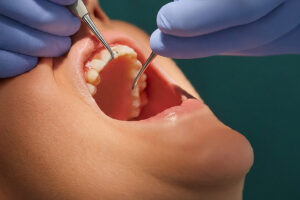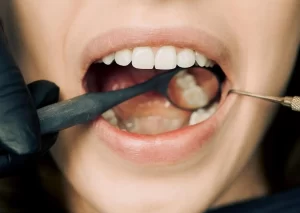Partial Dentures for Back Teeth

Losing back teeth can significantly impact your oral health and overall quality of life, affecting everything from your ability to chew food properly to your self-confidence.
Fortunately, partial dentures offer a practical and effective solution for those missing one or several back teeth.
In this article, we present partial dentures for back teeth, covering the various types available, the fitting process, and essential care tips to ensure your new dental appliance serves you well.
Table of Contents
How Do Partial Dentures Work?
Partial dentures are designed to replace missing teeth and are particularly useful for individuals who still retain some of their natural teeth. Unlike full dentures, which replace an entire set of teeth, partial dentures are used when one or more natural teeth remain in the upper or lower jaw.
They not only fill in the spaces created by missing teeth but also prevent other teeth from changing position. Here’s a closer look at how partial dentures work:
Structure and Materials
Partial dentures consist of replacement teeth attached to a pink or gum-colored plastic base, which may be connected by a metal framework that holds the denture in place in the mouth.
The materials used for the teeth can vary, including acrylic, composite, or porcelain, each offering different benefits in terms of aesthetics, durability, and cost.
Attachment
Partial dentures are anchored in place through various means, depending on the design and the individual’s needs. The most common methods include:
- Metal Clasps: These wrap around existing teeth to hold the denture in place securely.
- Precision Attachments: More aesthetically pleasing than metal clasps, these attachments are nearly invisible and attach to crowns placed on the natural teeth.
- Flexible Partials: Made from a thin, flexible material that adapts to the shape of the gums and teeth for a natural appearance and comfortable fit. They often do not require metal clasps for retention.
Functionality
By filling the gaps left by missing teeth, partial dentures restore a person’s ability to chew food properly and speak clearly. They also support the facial structure, preventing the sagging of facial muscles that can occur with tooth loss.
What Do Partial Dentures Look Like?
Here’s what partial dentures generally look like:

- Framework: The base of partial dentures is often made from a metal alloy, acrylic (plastic), or a flexible polymer material that matches the color of your gums. Metal frameworks are strong and durable, while acrylic and flexible polymer bases offer a more natural appearance.
- Teeth: The artificial teeth attached to the base are usually made from acrylic or porcelain. Porcelain teeth have a more natural appearance and are especially durable, making them an excellent choice for back teeth replacements. However, acrylic teeth are lighter and can be easier on the remaining natural teeth and gums.
- Clasps and precision attachments: Metal clasps or precision attachments are used to secure the partial denture to your natural teeth. Clasps wrap around existing teeth, while precision attachments are more discreet, often requiring modifications to the natural teeth they attach to.
- Design variations: Depending on the location and number of teeth missing, as well as the health of the remaining teeth, partial dentures can vary significantly in design. Some are relatively simple, replacing only one or two teeth, while others are more complex, replacing multiple teeth and requiring additional support.
- Color matching: For a natural look, the color of the artificial gums and teeth will be matched as closely as possible to your existing teeth and gum color. This customization helps ensure that the partial dentures blend seamlessly with your natural teeth, making them less noticeable.
Types of Partial Dentures for Back Teeth
Partial dentures for back teeth come in various types, each designed to accommodate different needs, preferences, and oral health conditions.
1. Cast Metal Partial Dentures
These are considered the standard in partial dentures due to their durability and strength. The framework is made of a metal alloy, which provides a sturdy base for the artificial teeth. The metal framework is covered with a gum-colored acrylic base, onto which the teeth are attached. Metal clasps or precision attachments are used to secure the denture to the natural teeth. Cast metal partials are less bulky and offer a comfortable fit, making them a popular choice for long-term use.
2. Acrylic Partial Dentures
Acrylic partial dentures are often used as a temporary or transitional solution while waiting for a more permanent denture or dental implant. They consist of artificial teeth set in an acrylic base, with metal clasps to attach to natural teeth. While they are more affordable, they tend to be bulkier and less comfortable than metal partials, making them less suitable for long-term use.
3. Flexible Partial Dentures
Made from a thin, lightweight, and flexible plastic material that adapts to the contours of the mouth, flexible partial dentures are a comfortable and aesthetically pleasing option. They do not require metal clasps; instead, they use gum-colored clasps that blend with the natural teeth, making them virtually invisible. Flexible partials are an excellent choice for patients allergic to acrylic or certain metals.
Why Is Replacing Missing Back Teeth Important?
Replacing missing back teeth is crucial for several reasons, impacting not only oral health but also overall well-being and quality of life.
Here are the key reasons why it’s important to replace missing back teeth:
Chewing and Nutrition
Back teeth, including molars and premolars, play a vital role in chewing food. Losing these teeth can make it difficult to chew food properly, which can lead to nutritional deficiencies.
Properly chewed food is essential for digestion and absorption of nutrients, so replacing missing back teeth can help ensure you are able to maintain a healthy, balanced diet.
Speech
Although front teeth are more commonly associated with affecting speech, back teeth also contribute to clear articulation. Missing back teeth can alter speech patterns or make certain sounds more difficult to pronounce, affecting communication.
Oral Health
When back teeth are missing, the remaining teeth can shift out of place, leading to misalignment and affecting your bite (occlusion). This can cause a range of issues, including difficulty in cleaning teeth properly, which increases the risk of tooth decay and gum disease.
The loss of back teeth can lead to bone loss in the jaw, as the bone begins to resorb or shrink in areas where there are no teeth to stimulate bone maintenance.
Facial Structure Support
Teeth provide support for the facial structure. Missing teeth, especially if multiple back teeth are missing, can lead to a sunken appearance in the cheeks, making a person look older than they are.
Replacing missing back teeth helps maintain the natural shape of your face and supports the lips and cheeks.
Preventing TMJ Disorders
The temporomandibular joint (TMJ) connects the jawbone to the skull. Missing teeth can alter the way the jaw closes, which can put additional stress on the TMJ, potentially leading to disorders that cause pain and dysfunction in the jaw joint and muscles that control jaw movement.
Self-Esteem and Quality of Life
Beyond the physical health implications, missing teeth can also impact mental health and self-esteem.
Many people feel self-conscious about their appearance when they have missing teeth, which can affect social interactions, professional opportunities, and overall quality of life.
Replacing missing back teeth can restore confidence in your smile and help you feel better about your appearance.
FAQ on Partial Dentures for Back Teeth
What are my options if I have no back teeth?
If you have no back teeth, your options include partial dentures, fixed bridges, and dental implants. Each solution offers different benefits, from removable options like partial dentures to more permanent solutions like implants, which provide stability and support for jaw health.
What do back dentures look like?
Back dentures are designed to mimic the appearance of natural teeth and gums. They typically consist of a gum-colored base that supports artificial teeth, made to match the color and shape of your remaining teeth for a natural look.
What are the most comfortable partial dentures?
Flexible partial dentures are often considered the most comfortable option. Made from a soft, flexible material, they adapt to the shape of your mouth, providing a snug fit without the need for metal clasps.
Can you get dentures just for your back teeth?
Yes, you can get partial dentures specifically designed for back teeth. These are an ideal solution for individuals missing one or several back teeth, helping to restore function and prevent remaining teeth from shifting.
Can you eat with back dentures?
Yes, you can eat with back dentures. They are designed to restore the ability to chew efficiently, although it may require some adjustment period to get used to the sensation and mechanics of chewing with them.
Do you have no teeth while waiting for dentures?
In some cases, immediate dentures are provided the same day as tooth extraction, so you’re not without teeth. For traditional dentures, a waiting period is necessary for gums to heal, during which temporary solutions may be offered.
Sources and citations:
Fact Checked
Our dedicated team rigorously evaluates every article and guide to ensure the information is factual, up-to-date, and free of bias.
Updated Regularly
We update our articles and reviews regularly to ensure you have access to the latest data in the dental industry.
The content on Dental3DU’s blog is intended for educational purposes only. This information should not be relied upon as professional medical counsel. Be sure to always consult with your dentist about the dangers and benefits of any medication, treatment or procedure.







